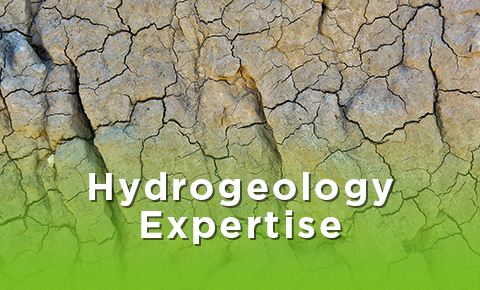Hydrogeology Expertise: Our Approach to Site Evaluation and Remediation
May 7, 2020

Hydrogeology is the study of groundwater distribution and movement over the ground surface and through soils and rocks. At McFadden Engineering (MEI), we have a team of professional Engineers and Geologists who specialize in hydrogeology. Contaminants that reach the soil frequently become a two-part problem as both the soil and the groundwater in the soil can be affected.
Groundwater, Surface Water and Groundwater Contamination
Groundwater is water (liquid or frozen) that has seeped below the earth’s surface and is stored in the spaces between soil or rock particles. An aquifer is created when a large amount of groundwater is stored in the same place. Groundwater flows through the soil or rock under the influence of gravity, usually on the order of a few inches to a few feet per year. Surface water is water (liquid or frozen) located above the surface of the ground, including stormwater runoff, streams, creeks, rivers, glaciers, ponds, lakes and oceans. Surface water usually flows more quickly than groundwater.
Soil and groundwater contamination impacts the public and the environment in many ways:
- It can affect drinking water quality and can lead to health maladies associated with drinking contaminated water.
- Contamination can devalue property and limit future uses for that property.
- When buildings or residences are built on top of contaminated soil there may be a danger of vapors traveling up through foundations and into the air inside, where people may breathe in toxic compounds.
- Natural habitats for wildlife may be lost in areas with contaminated soil and groundwater. This is particularly true for aquatic habitats.
Site Evaluation and Remediation Approach
When it comes to our hydrogeology expertise and working with clients, we evaluate the entire site including the soil, the groundwater, and the surface water to determine the extent of the problem our clients might be facing. In addition, we also hold expertise in EPA standards and compliance regulations; software such as SW2 help us understand the issues faced by different construction projects, and knowing how to read epa swmm helps us turn data into actionable insights.
When it comes to site solutions, remediating the soil is usually the easiest option. If the area can be excavated, removing the impacted soil and disposing of the material is typically the quickest and cheapest option. However, when contamination is under a building or other structure, or it reaches the groundwater in the soil, the situation is often more complex. Furthermore, regulatory agencies are more sensitive to groundwater issues because groundwater is mobile and can travel off-site.
To tackle these challenges, we construct subsurface cross-sections and use groundwater modeling to develop hydraulic flow models for sites. These models help us predict groundwater flow direction and velocity, and indicate the best place to attack the issue with remediation systems. Using these tools and our experience in dealing with these issues, we can develop a cost-effective approach to cleaning up the site while meeting the regulatory requirements that may be present.
Timeline for Cleanup
Many variables can play a part in the timeframe for cleanup work. These can include:
- Cost of remediating a site and how much funding is available to spend to solve the problem.
- The chemical/physical nature of the contaminating chemical(s). For example, if the chemical dissolves easily in groundwater, it is easier to deal with than a chemical that separates itself from water (think oil/water).
- The concentrations of the contaminants in soil or groundwater will affect how long it takes to remove them or break them down.
- The response of time of state regulators is a big factor. It can take months to get approval from ADEM or another state’s regulatory agency to proceed with a remediation plan.
Best Management Practices
McFadden Engineering also specializes in designing Best Management Practices (BMPs) required at many sites. BMPs help minimize runoff that can ultimately allow contaminants to enter the surface water and groundwater. We can help keep clients in compliance by designing a Best Management Practices program, obtaining the necessary permits, and performing the required monitoring to help maintain compliance.
Our team has the personnel, tools and experience needed to help you develop a solution to solve your on-site challenges. If you have questions or are looking for project assistance, contact our team.